Many of the ideas and technologies used for the first time in the Porsche 911 have their origins in motorsport. After all, the 911 was always dedicated to the principle of high performance and motor racing was its most important testing ground. From the outset it was a regular participant on racetracks and rally circuits all over the world and proved itself a multifaceted and reliable winning vehicle. Yet the 911 was seldom the most powerful car in the field. It was, however, always the most efficient. Typically Porsche, in fact.
A good two thirds of what are now around 30,000 victories for Porsche are down to the 911. That’s no surprise, as F. A. Porsche’s stroke of genius shows inexhaustible potential for technical development not just for road use, but in motorsport as well. With rear or mid-mounted engine, with or without turbocharger, with all-wheel or rear-wheel drive, in classic trim or extremely streamline carbon fibre outfit, the 911 became and remains a regular on the list of winners of the world’s greatest races and rallies.
The cooperation with client teams is of great importance to Porsche. This strategy has proved its worth since the early days, with the factory leading the way as the innovative force and the clients then benefiting directly from the research and development and work. In return the clients’ successes have contributed to the winning of numerous major championships.
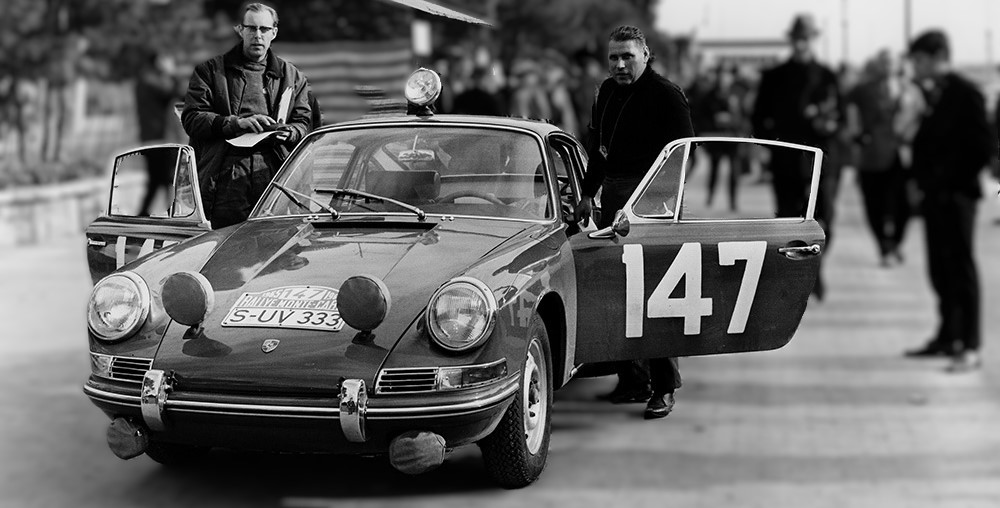
The trail of success began in 1965: at the Monte Carlo Rally, made extremely difficult by bad weather, the Porsche 911 2.0 proved its qualities in top international motorsport for the first time. After 4,600 kilometres, often in driving snow, no more than 22 of the 237 vehicles to start made it to the finish. Porsche employees Peter Falk and Herbert Linge completed the rally with victory in their class and an outstanding fifth place in the overall rankings. With a 100-litre petrol tank, shorter gearing ratio, differential lock and sports suspension, this 911 was excellently equipped for rallying. In 1966, four 911 cars took the first four places in the Gran Turismo classification. In 1967, a 911 S works car won the two-litre class at the Targa Florio. British all-round talent Vic Elford took the European Championship with the 911 S 2.0 ‘Rallye’.
In 1968, Vic Elford secured the first overall victory for Porsche at the Monte Carlo Rally. In 1969 and 1970, Björn Waldegård repeated the feat, with 180 horsepower (132 kW) from a 2.2-litre engine already available to the Swede for his 911 S, which weighed in at just 960 kilograms. In 1978, Frenchman Jean-Pierre Nicolas, driving a privately entered three-litre Carrera RS, beat off every works team in the snow-induced chaos and gained what for a while would be the last overall victory for Porsche at the classic rally in the French Maritime Alps.
The reliability and speed of the Porsche 911 was underlined by numerous other rally successes. In 1966, Günther Klass won the European Championship in a 911 and in 1967 Sobieslaw Zasada was successful with a 911 S (and a 912) in Group 1 (for cars with only minor modifications), while Vic Elford won Group 3 for more highly modified GTs.
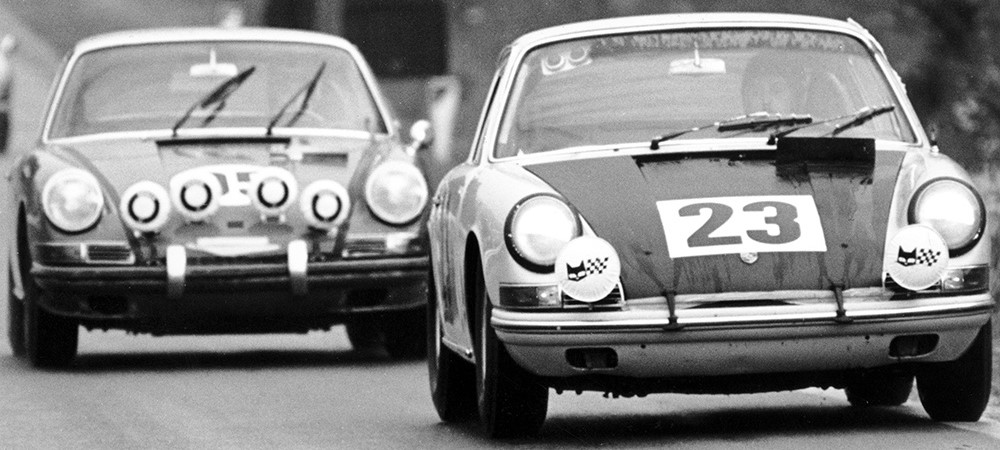

In 1968, the European Champion was Pauli Toivonen and his car was a 911 T. At that time, the European Championship was the highest-ranking rally championship in the world, with its gruelling races, such as the Monte Carlo Rally, the Austrian Alpine Rally, the Rally of Sweden and the San Remo Rally, placing extreme demands on the drivers and their cars. The Porsche 911 won them all – some more than once. In 1970, the Porsche works team with Björn Waldegård won the international one-cup championship – the forerunner of the World Rally Championship.
Success on the track: the triumphal procession of the 911 in the GT categories
However, even more clearly than in rallying the 911 dominated on the racetrack, where mid-engine racing cars, such as the 904 Carrera GTS, the 906 Carrera 6, the 908 and the legendary 917 initially took overall victories and titles, while the 911 began its run of success in the GT (Gran Turismo, Grand Touring) categories.
As early as 1966, Porsche clients were already achieving internationally significant successes with the 911 S, including a win in the two-litre class at the 24-hour race in Daytona achieved by Jack Ryan and Art Benker and the first class victory at Le Mans by ‘Franc’ and Jean Kerguen.
In 1967, clients picked up 13 national titles in the categories for modified production cars, including a championship in the major American TransAm, where the 911 was champion’s car in 1968 and 1969 as well. The 911 won in its class at Daytona, Sebring, Spa, in the Targa Florio and on the Nürburgring. The first overall victory in the 24-Hours of Spa came as soon as 1967, with the Porsche teams completing the hat-trick in 1968 and 1969.
For works use and client motorsport Porsche produced in 1967 the limited edition 911 R. The prototype had a Carrera 6 engine delivering 210 hp – ample power for a weight of just 830 kilograms. Driving the new car, Vic Elford, Hans Herrmann and Jochen Neerpasch immediately won the ‘Marathon de la Route’, an 84-hour race on the Nürburgring – the new, semi-automatic ‘Sportomatic’ gearbox also survived the torture without complaint. That November in Monza the car set numerous world speed records.
In 1970, the motorsport division built for works driver Gérard Larrousse the lightest 911 ever to be licensed for use on the road: the 911 ST for the Tour de France weighed in at all of 789 kilograms. Legend has it that Larrousse promised the mechanics a crate of champagne for every kilo below the 800-mark… Larrousse came third – beaten only by two Matra prototypes.
Until 1972, the Porsche 911 S, 911 R and 911 T remained the cars to beat. The 911 S 2.3 of 1971 had a power output of 240 hp. One year later, a flat engine increased in size to 2.5 litres was already producing 270 horsepower. It was almost impossible to keep track of all the victories and titles, with the winning of the GT European Cup in 1971, 1972 and 1973 being the standout achievements.
In 1972, based on the RS 2.7, Porsche Motorsport built the 911 Carrera RSR 2.8 for use in several series, including the one-cup world championship. Among 911 lovers it has been one of the most admired models ever since. The RSR 2.8 weighed just 890 kilograms, while its six-cylinder engine, enlarged by 100 cc, delivered around 300 hp (221 kW) – 90 hp more than the RS 2.7. The chassis was largely the same as on its predecessor, though the brake system was made even more powerful. The very first appearance of the 911 Carrera RSR 2.8, at the 24 Hours of Daytona in 1973, was a triumph, as Peter Gregg and Hurley Haywood achieved overall victory against far more powerful GTs and prototypes. Gregg and Haywood, this time joined by Dave Helmick, won the second great US classic, as well: the 12-hour race in Sebring. At Le Mans a works RSR, finishing behind three prototypes, only just missed out on the podium. Another outstanding achievement was the victory at the final Targa Florio in 1973, when Herbert Müller and Gijs van Lennep in an RSR completed the race, which counted towards the one-cup world championship, in the fastest time and thus secured the eleventh overall win for Porsche.
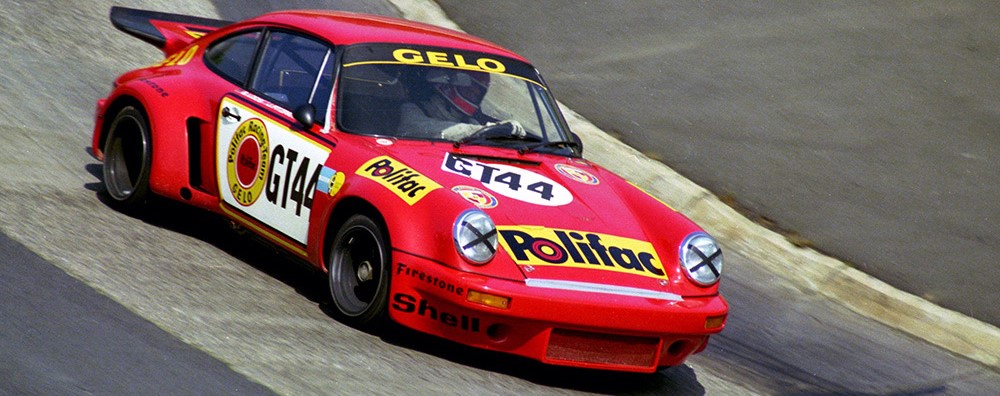
For the 1974 season there followed in the shape of the Carrera RSR 3.0 an even more powerful version for the racetrack with a 2,994 cc engine that output 330 hp (243 kW). Exclusively designed for racing, the RSR 3.0 featured a distinctive large rear tail and very broad wings. Porsche easily won the GT European Championship and practically all other significant GT championships of that year.
Leading the development of the 911 in racing trim was engineer Norbert Singer, who would later be responsible, among other achievements, for the legendary 935 and the 956/962C. Responsible for the race and rally engines was Hans Mezger, the father of the 911 engine.
In the 1974 FIA GT European Cup the first eight places went to Porsche. Clients running the 911 also won the IMSA and TransAm championships in the USA. A year later, Carrera RSR cars occupied all top ten places in the GT European Championship. Client teams won numerous national championships as well.
Even as the RSR was still racing from success to success with naturally aspirated engines, Porsche was working flat out on a turbo drive system, aimed at making the 911 capable of overall victory in the top categories of future championships. Porsche had already had experience in 1972 and 1973 with the turbocharged 12-cylinder engine of the 917, which as the 917/30 delivered up to 1,400 hp (1,029 kW) and dominated the CanAm race series.

1972: The 911 Carrera RS 2.7 begins its legendary career
In launching the 911 Carrera RS 2.7, Porsche introduced in 1972 one of the world’s most successful GT sports cars – and one of the style icons of sports car design. ‘Ducktail’ was the buzzword, the famous spoiler on the engine compartment hood.
The RS 2.7 was the first 911 with the suffix ‘Carrera’ and also the first with differing tyre sizes on front and rear axle. The 210 hp (154 kW) Porsche, weighing 1,075 kilos and doing 245 km/h wowed the market: while initially just a production run of 500 for homologation in motorsport was planned, Porsche ultimately sold over 1,500 units of the high-performance sports car.
At the East African Rally in 1973 and 1974, the RS 2.7 missed out on overall victory due only to ‘minor faults’ and took second place. In 1974, Porsche drivers in the RS 2.7 had numerous successes, including winning the German Rally Championship. For use on asphalt racetracks the motorsport department created a motoring gem with the name 911 Carrera 2.8 RSR.
At the East African Safari Rally of 1978 Vic Preston and Björn Waldegård set off in two Porsche 911 SC cars on the 5,000 kilometres of ongoing torture. After leading for a long time, they ultimately came home second and fourth.
In 1981, double rally world champion Walter Röhrl wrote his name into the history books as, in his rear-wheel drive 911 SC 3.0, he fought a breathtaking battle with the all-wheel drive Audio Quattro on the San Remo Rally – and missed out on what seemed set to be victory just short of the finishing line with a broken drive shaft.
At the end of 1983, Porsche brought out the limited edition 911 SC RS. Based on the 911 SC this car, known internally as the ‘954’, had a three-litre naturally aspirated engine, which in rally trim produced 250 hp (184 kW). Its unladen weight was just 1,057 kilograms and like all 911 models, this rear-wheel drive car also had outstanding traction. Porsche clients began winning with the 911 SC RS right away, including the Middle East Rally Championship in 1984.
In that same year, Porsche won for the first time at the Paris-Dakar Rally. In what is the world’s toughest marathon René Metge drove a 911 Carrera 4×4 (Type 953) into first place. It was the first victory by a grand tourer at the ‘Dakar’, which until then had been dominated by specially prepared all-terrain vehicles.
The first ever all-wheel drive 911 was powered by a standard 3.2-litre engine with reduced compression and 225 hp (165 kW). Special features on the Type 953 included a fully lockable centre differential and a double wishbone front axle, plus two shock absorbers on each side. Two fuel tanks held a total of 270 litres of petrol.
In 1985, Porsche picked up no trophies from a first trial run at the ‘Dakar’ with the pioneering 959, but gained important technical insights and won with the all-wheel drive car that same year at the Pharaohs Rally in Egypt. In 1986, the 959 came up trumps at the Paris-Dakar – the toughest ever in the rally’s history.
Of over 280 cars at the start no more than 31 completed the 13,800 gruelling kilometres through the Sahara. The sports car, with innovative, electronically adjusted chassis and all-wheel drive, plus, thanks to a sequential twin-turbo, engine power of around 400 hp (294 kW), scored a triumphal one-two victory: René Metge ahead of Jacky Ickx.
Even the third 959, entered as a ‘racing workshop’, with project leader Roland Kussmaul at the wheel made it into the top 10, finishing in sixth place. It was thus a total success in this test of strength for the 959, which in its road car form fascinated fans of vehicle technology all over the world.

1974: 911 Carrera RSR 2.1 Turbo – the first turbocharged race car
The engine delivered output of around 500 hp (368 kW) and in the race twice around the clock it proved itself superbly. Weighing just 825 kilograms, with a huge rear wing and extreme widening of the body for the rear wheels from the 917, the Porsche finished in second place – a race car based on the production model thus broke into the phalanx of the hollow frame prototypes with their Formula 1 engines.
Overall victory would have been possible, as the leading Matra was stuck in the pits on the Sunday morning with a gearbox problem. However, two top mechanics from Porsche repaired the fault in record time and rescued the win for the French. The reason they did so was that the Matra gearbox was one developed by Porsche.
The 911 Carrera RSR 2.1 Turbo was the forerunner of the 934 and 935 models, which were developed based on the 911 Turbo (930) road car and were used from 1976 in the one-cup world championship and many national championships. Closer in engineering terms to the road car was the 934.
The chassis and aerodynamics were largely the same as on the production model, while the brake system came from the 917. A turbocharger helped the three-litre engine to produce a good 485 hp (357 kW). By increasing the charge pressure, client teams were soon achieving a steady 580 hp and were in an untouchable class of their own as they competed for the GT European Championship in the Group 4 category for modified production cars. In the USA the 934 won the TransAm.


The Group 5 category allowed more far-reaching modifications to the base vehicle, as long as the original silhouette was retained. Type 935 racing sports cars became the benchmark here. Initially delivering around 590 hp (434 kW) and with its unique front section, the car weighed 970 kilograms (with 70 kilograms of lead ballast). At the start of 1976, the headlights still stood upright. As, however, the rule book allowed free design of the front wings, Norbert Singer removed the headlight domes and smoothed the front down, which improved aerodynamics in racing use. This ‘flat nose’ version was unveiled in 1977, with the headlights then situated in the front spoiler.
With works drivers Jacky Ickx and Jochen Mass, Porsche immediately won the 1976 World Championship for Manufacturers and returned to the championship the following year. Now with a twin turbocharger and around 630 hp (463 kW), the 935 again took the title, with not only the works team but also highly professional client teams successfully picking up points.

In the late seventies, the DRM German Racing Championship was run in two divisions for vehicles with engine capacity of up to and over two litres. From 1977 to 1979, Porsche clients won the championship in the ‘top’ division. In 1977, the factory entered the 935/2.0 ‘Baby’ on a trial basis in the very popular ‘lower’ division. It had a 1.4-litre turbo engine, which when calculating in the ‘Turbo factor’ remained at just under 2,000 cc. The power train delivered 380 hp (279 kW).
The extremely lightweight construction methods led by Norbert Singer were so successful that the team had to put 25 kilograms of lead ballast in the front of the car in order to achieve the required minimum weight of 750 kilograms. The ‘Baby’ went down in history as the lightest 911 ever built – and won the DRM race at Hockenheim half a lap ahead of the competition.

1978: ‘Moby Dick’: mixed cooling and 366 km/h
The most extreme 911 is the Porsche 935/78 ‘Moby Dick’ from 1978. Externally alone it differs from its predecessors with its much lower body and powerful long rear-end. The ‘Moby Dick’ is trimmed for high speed. At Le Mans a top speed of 366 km/h was measured.
For the first time in the history of the 911, the twin-turbo engine, now with a 3.2-litre capacity, was given water-cooled cylinder heads, in which four valves were arranged per cylinder. The cylinders remained air-cooled. The power train delivered ca. 845 hp (621 kW). In 1978 too, Porsche successfully defended its title in the one-cup world championship.
A year later, a client team’s 935 ‘K3’ won at Le Mans – and for many a year this was to remain the only overall victory by a race car based on a street-legal model. Second and third places also each went to a Porsche 935, while fourth place was taken by a 934. Thanks above all to the uniquely close cooperation with client teams, Porsche again won the one-cup world championship in 1979 and 1980. In the same years, Porsche clients took the titles in the important IMSA and TransAm championships in the USA.
The FIA Driver’s Endurance World Championship also went in 1980 and 1981 to 935 drivers. For numerous races the 935 went down in the annals as the car with the record number of wins. At Sebring alone this production race car remained unbeaten from 1978 to 1982 and won again in 1984. At Daytona the most extreme of all 911 models took overall victory from 1978 to 1983 in unbroken succession.
While the 935 gained success after success in the ‘Silhouette Formula’, the standard 911 models also demonstrated the sporting abilities of the classic cars from Stuttgart. In 1976, on the Nordschleife of the Nürburgring Fritz Müller and Herbert Hechler together with Karl-Heinz Quirin secured Porsche’s first win in the Nürburgring 24 Hours Race in a 911 Carrera RS. With further victories in the 911 in 1977 and 1978, Müller and Hechler completed the first hat-trick by any manufacturer in the history of the event, perhaps the toughest endurance race in the world.
The 935 remained in use by clients until the middle of the 1980s. The spotlight by now, however, was on a different Porsche, which was not based on the 911: when for the 1982 season the Fédération Internationale de l’Automobile (FIA) formulated new rules for sports cars and prototypes, Porsche was already well prepared with the 956 C.
The revolutionary ‘ground-effect’ prototype went on to win race after race. In Formula 1 the ‘TAG Turbo’ engine developed and built by Porsche powered a McLaren to world championship titles in 1984 and 1986. At the end of the eighties, Porsche turned its attention to motorsport in the USA, while the 962 C and 962 IMSA achieved further racing success.
Based on the 911, Porsche kept on producing small runs of competitive cars (e.g. the 911 SC RS, see above) and prototypes for motorsport. In 1986, making its very first start at Le Mans, the all-wheel drive 961 won in the IMSA/GTX class and came a very creditable seventh in the overall standings.
Behind the 961 name was the 640-hp (471 kW) race version of the 959, with its pioneering technology passing here an endurance test that could scarcely be any tougher. In 1987, the works team returned to Le Mans with the 961, featuring a twin-turbo six-cylinder engine that now produced 680 hp (499 kW). Its race ended in an accident, but the driver was unhurt.
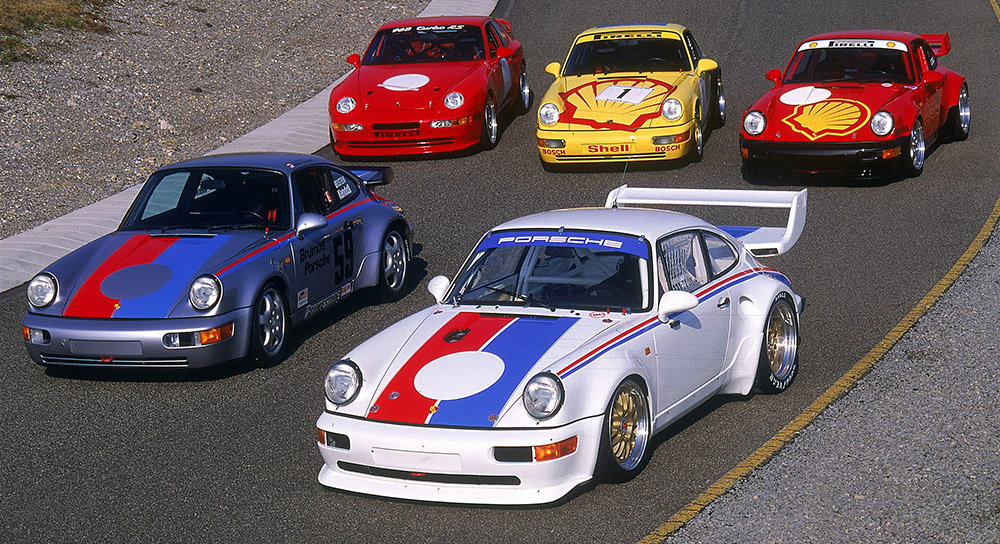
The 1990s: renaissance of the GT racing cars
With the end of the spectacular prototypes such as the 962 C, the sport experienced a renaissance at the start of the 1990s with Gran Turismo racing cars more or less unmodified from the production models. Porsche supported this trend with numerous developments of the 911 tailored to the respective countries and race series.
In the USA the 911 Turbo dominated the IMSA Supercar Championship from 1991 to 1993. Also in 1993, numerous client teams celebrated the 30th birthday of the 911 in their own way. Driving a Turbo S Le Mans GT, with a 3.16-litre twin-turbo, 474 hp (348 kW) and unladen weight of 1,000 kilos, the ‘Dream Team’ of Röhrl/Stuck/Haywood won in their class at Sebring.
A Carrera RSR 3.8 with a 3.8-litre naturally aspirated engine and 350 hp (257 kW) was the first GT waved across the line at the 24 Hours of Le Mans. In the Nürburgring 24-Hour Race the RSR 3.8 was also unbeatable, leading three further 911 cars over the finishing line – making it the first time in the history of the race that four cars of the same make had taken the first four places. This GT racing car also made the headlines with overall victory in the 24 Hours of Spa-Francorchamps.
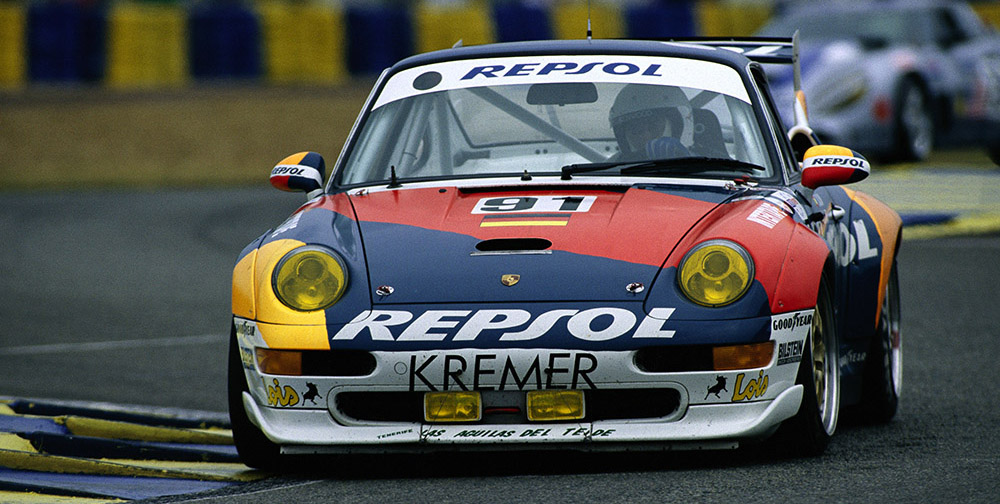
In 1995, the success story of the 911 continued in impressive style. The magic word now was predominantly the 911 GT2, with which a privateer team clearly won the BPR Endurance Championship, while US client teams comfortably won both the SCCA World Challenge and the IMSA Exxon-Supreme GTS2 Championship in the USA. The list of successes is simply endless, containing such prestigious further championships as the ADAC GT Cup and the All Japan GT Championship. As successor to the RSR 3.8 the 911 GT2 R produced from a 3.6-litre twin-turbo engine initial power output of 450 hp (330 kW). Depending on the rules of the different championships this could be increased to around 485 hp (345 kW). As the 911 GT2 Evolution for the highest GT category (GT 1) this racing sports car could even mobilise 600 hp (442 kW).

1996: 911 GT1 – the first mid-engine 911
The body was made of carbon fibre / Kevlar. Weighing 1,050 kilograms, the car performed superbly against the prototypes and took both second and third places in the overall final standings at Le Mans, with Porsche clearly winning the GT class. A year later, Porsche was back at Le Mans with the 911 GT1 Evolution. The cars featured optimised aerodynamics, modified chassis and enhanced engine management. However, both GT1 Evo cars retired shortly before the finish. For later outings in the FIA GT Championship the vehicle had the first sequential gearbox in a racing car based on the 911.
Clients came up trumps with the 911 GT2 in 1996 as well, with successes including class victories at Le Mans, Daytona and Sebring. The SCCA World Challenge and the BPR Endurance Championship also went once again to the Porsche teams and drivers. In 1997, client teams running the 911 GT2, 911 GT2 Evo and 911 GT1 seamlessly continued the great achievements of the previous year.
By 1998 the time had come: with a once again greatly modified 911 GT1 – the first Porsche racing car with a carbon fibre monocoque – the Porsche works team secured a one-two win at Le Mans to coincide precisely with the company’s 50th anniversary. Clients all over the world continued to achieve success with the GT2 and GT1 Evo. Highlights included victories in the GT1 and GT2 classes at Daytona and the GT2 victory at Sebring. The works team finished the season in second place in the FIA GT1 Constructors’ Championship.
Lining up at the start at Le Mans in 1999 was the brand new 911 GT3 R with a fully water-cooled engine. 415 hp (305 kW) was produced by the 3.6-litre flat engine, with which a works-backed independent team immediately won in their class. Running the race versions of the GT3 R, the RS (from 2002) and the 455-hp (335 kW) GT3 RSR (from 2004), Porsche clients – some backed by the factory – won ten drivers’ and eight team championships in the GT class of the American Le Mans Series (ALMS) between 1999 and 2010. In the American GrandAm too the GT3 was for a long time almost unbeatable. From 1999, Porsche drivers won seven driver’s titles, six team titles and eight manufacturer’s crowns. Porsche clients enjoyed similar success in the FIA GT Championship and in numerous national championships.
Following the victorious debut in 1999, came eight further class wins against strong competition for the GT3 R, RS and RSR in the years up to 2010. At the 24-hour race in Daytona in 2003, a 911 GT3 RS repeated the coup of 1973 – a modified Porsche production car again beat the prototypes and took overall victory. On the Nürburgring as well, the world’s most demanding circuit, the 911 GT3 proved its potential. Four overall wins in succession were achieved here from 2006 (GT3 MR) to 2009 (all GT3 RSR). In 2011 came the latest overall win by a 911 GT3 RSR in the ‘Green Hell’.


You must be logged in to post a comment.